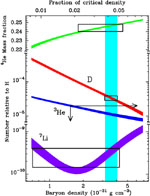


4.5. Primordial Nucleosynthesis
Given our time constraints, even some of the more important concepts in cosmology cannot be dealt with in significant detail. We have chosen just to give a cursory treatment to primordial nucleosynthesis, although its importance as a crucial piece of evidence in favor of the big bang model and its usefulness in bounding any new physics of cosmological relevance cannot be overstated.
Observations of primordial nebulae reveal abundances of the light elements unexplained by stellar nucleosynthesis. Although it does a great disservice to the analytic and numerical work required, not to mention the difficulties of measuring the abundances, we will just state that the study of nuclear processes in the background of an expanding cooling universe yields a remarkable concordance between theory and experiment.
At temperatures below 1 MeV, the weak interactions are
frozen out and
neutrons and protons cease to interconvert. The equilibrium
abundance of neutrons at this temperature is about 1/6 the
abundance of protons (due to the slightly larger neutron mass).
The neutrons have a finite lifetime
( n = 890 sec) that
is somewhat larger than the age of the universe at this epoch,
t(1 MeV)
n = 890 sec) that
is somewhat larger than the age of the universe at this epoch,
t(1 MeV)  1
sec, but they begin
to gradually decay into protons and leptons. Soon thereafter,
however, we reach a temperature somewhat below 100 keV, and
Big-Bang nucleosynthesis (BBN) begins. (The nuclear binding energy
per nucleon is typically of order 1 MeV, so you might expect that
nucleosynthesis would occur earlier; however, the large number of
photons per nucleon prevents nucleosynthesis from taking place
until the temperature drops below 100 keV.) At that point
the neutron/proton ratio is approximately 1/7. Of all the light
nuclei, it is energetically favorable for the nucleons to reside
in 4He, and indeed that is what most of the free neutrons are
converted into; for every two neutrons and fourteen protons, we
end up with one helium nucleus and twelve protons. Thus, about
25% of the baryons by mass are converted to helium. In addition,
there are trace amounts of deuterium (approximately 10-5
deuterons per proton), 3He (also ~ 10-5), and
7Li (~ 10-10).
1
sec, but they begin
to gradually decay into protons and leptons. Soon thereafter,
however, we reach a temperature somewhat below 100 keV, and
Big-Bang nucleosynthesis (BBN) begins. (The nuclear binding energy
per nucleon is typically of order 1 MeV, so you might expect that
nucleosynthesis would occur earlier; however, the large number of
photons per nucleon prevents nucleosynthesis from taking place
until the temperature drops below 100 keV.) At that point
the neutron/proton ratio is approximately 1/7. Of all the light
nuclei, it is energetically favorable for the nucleons to reside
in 4He, and indeed that is what most of the free neutrons are
converted into; for every two neutrons and fourteen protons, we
end up with one helium nucleus and twelve protons. Thus, about
25% of the baryons by mass are converted to helium. In addition,
there are trace amounts of deuterium (approximately 10-5
deuterons per proton), 3He (also ~ 10-5), and
7Li (~ 10-10).
Of course these numbers are predictions, which are borne out by
observations of the primordial abundances of light elements.
(Heavier elements are not synthesized in the Big Bang, but require
supernova explosions in the later universe.) We have glossed over
numerous crucial details, especially those which explain how the
different abundances depend on the cosmological parameters. For
example, imagine that we deviate from the Standard Model by
introducing more than three light neutrino species. This would
increase the radiation energy density at a fixed temperature,
which in turn decreases the timescales associated with a given
temperature (since t ~ H-1

 R-1/2).
Nucleosynthesis would therefore
happen somewhat earlier, resulting in a higher abundance of
neutrons, and hence in a larger abundance of 4He. Observations
of the primordial helium abundance, which are consistent with the
Standard Model prediction, provided the first evidence that the
number of light neutrinos is actually three.
R-1/2).
Nucleosynthesis would therefore
happen somewhat earlier, resulting in a higher abundance of
neutrons, and hence in a larger abundance of 4He. Observations
of the primordial helium abundance, which are consistent with the
Standard Model prediction, provided the first evidence that the
number of light neutrinos is actually three.
The most amazing fact about nucleosynthesis is that, given that the universe is radiation dominated during the relevant epoch (and the physics of general relativity and the Standard Model), the relative abundances of the light elements depend essentially on just one parameter, the baryon to entropy ratio
 |
(126) |
where nB = nb -
n is
the difference between the number of baryons and antibaryons per unit
volume.
The range of
is
the difference between the number of baryons and antibaryons per unit
volume.
The range of  consistent with the deuterium and 3He primordial
abundances is
consistent with the deuterium and 3He primordial
abundances is
 |
(127) |
Very recently this number has been independently determined to be
 |
(128) |
from precise measurements of the relative heights of the first two microwave background (CMB) acoustic peaks by the WMAP satellite. This is illustrated in figure (4.9) and we will have a lot more to say about this quantity later when we discuss baryogenesis.
 |
Figure 4.9. Abundances of light elements produced by BBN, as a function of the baryon density. The vertical strip indicates the concordance region favored by observations of primordial abundances. From [47]. |